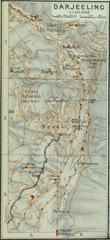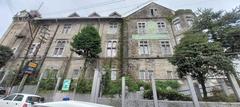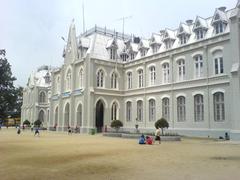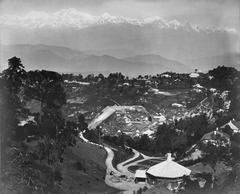Mag-Dhog Yolmowa Monastery: Visiting Hours, Tickets, and Attractions in Darjeeling
Date: 04/07/2025
Introduction
Mag-Dhog Yolmowa Monastery, also known as Aloobari Monastery, stands as a symbol of spiritual heritage and cultural preservation in the tranquil hills of Darjeeling, West Bengal. Founded in 1914 by Sri Sangay Lama during the tumultuous times of World War I, the monastery was envisioned as a sanctuary dedicated to peace and harmony—its name literally translates to “warding off the war.” It is deeply rooted in the Yolmo community, an ethnic group originally from northeast Nepal, who continue to uphold their religious and cultural traditions through the monastery’s activities.
The monastery’s unique blend of Tibetan and Nepali architectural elements, vibrant murals painted with natural herbal pigments, and serene ambiance draw pilgrims, travelers, and culture enthusiasts alike. It serves as a living repository of Yolmo culture and Buddhist teachings, hosting regular rituals, festivals, and monastic training. This guide offers a comprehensive overview of Mag-Dhog Yolmowa Monastery’s history, architectural highlights, visiting hours, accessibility, and practical travel tips, helping you plan a meaningful visit to one of Darjeeling’s most cherished landmarks.
For further planning and insights, refer to sources such as Swarnab Dutta’s guide, Tripopola, and 1001things.org.
Origins and Founding
Mag-Dhog Yolmowa Monastery’s foundation in 1914 is closely tied to the Yolmo people, who migrated from northeast Nepal and established a vibrant Buddhist community in Darjeeling. Under the guidance of Sri Sangay Lama, the monastery was constructed as a spiritual response to the global conflict of World War I, with a mission to promote peace, compassion, and non-violence (Wikipedia; 1001things.org).
Architectural and Artistic Heritage
Architectural Design
Perched along the Old Military Road (Aloobari Road), about 3 km from Darjeeling town, the monastery features traditional Himalayan Buddhist architecture with a harmonious combination of stone, wood, and brightly painted motifs (Swarnab Dutta; Clubside.in). The sloping roofs and intricate woodwork are characteristic of the region’s religious structures, while the colorful prayer flags and gateway adorned with auspicious symbols set a tranquil and spiritual tone.
Artistic Features
Inside the main prayer hall, visitors encounter polished wooden floors, thangka paintings, and murals that illustrate Buddhist cosmology and stories from the Jataka tales. These artworks, painted with herbal pigments, not only enhance the spiritual ambiance but also reflect ancient Himalayan artistic practices (Indianetzone). The altar houses statues of Lord Buddha and Padmasambhava (Guru Rinpoche), as well as Tara Devi and Lakshmiswari, representing compassion and benevolence.
The monastery grounds are also lined with rows of prayer flags in five symbolic colors and prayer wheels that devotees spin as they recite mantras, believed to spread peace and goodwill.
Preserving Yolmo Culture
Beyond its role as a spiritual sanctuary, Mag-Dhog Yolmowa Monastery is a cornerstone of Yolmo cultural identity in Darjeeling. The monastery hosts traditional rituals, festivals such as Losar (Tibetan New Year) and Buddha Purnima, and provides monastic education to over 200 monks (Trawell.in). These activities ensure the survival of Yolmo customs, language, and Buddhist teachings far from their ancestral homeland.
Visiting Mag-Dhog Yolmowa Monastery
Location and Getting There
- Address: Aloobari Road, about 3–4 km from Darjeeling town center.
- By Road: Accessible by taxi, auto-rickshaw, or a scenic walk from Chowrasta (30–40 minutes).
- Nearest Airport: Bagdogra (70 km); nearest railway: New Jalpaiguri (75 km).
(Tripopola; Travel with Rakesh)
Visiting Hours
- Open Daily: 9:00 AM – 4:00 PM (some sources state 5:00 PM; hours may vary during festivals).
Entry and Tickets
- Entry Fee: Free; donations are appreciated to support maintenance and community activities.
- Tickets: No formal ticketing system; guided tours may be arranged locally.
Guided Tours and Special Events
- Guided Tours: Available upon request, especially during festivals or by arrangement with local agencies.
- Special Events: Major Buddhist festivals present unique opportunities to witness rituals, cultural performances, and display of ancient manuscripts.
Accessibility
- Physical Access: The paved approach has a gentle incline and a few steps; may be challenging for wheelchair users or those with mobility issues (Styles at Life).
- Facilities: Restrooms and a small seating area available; local tea stalls nearby.
Photography
- Outdoors: Generally permitted.
- Indoors: Seek permission before photographing inside prayer halls or during ceremonies.
On-Site Experience and Etiquette
- Atmosphere: Peaceful, meditative environment with gentle prayers and panoramic views of the Himalayas.
- Dress Code: Modest clothing required; shoes must be removed before entering halls.
- Etiquette: Maintain silence, avoid disturbing prayers, and do not touch sacred objects. Respect monastic rules—greet monks with a bow or “namaste,” and ask before photographing.
- Ideal Duration: 1–2 hours.
Best Time to Visit
- Spring (March–May): Pleasant weather, blooming rhododendrons.
- Autumn (October–November): Clear skies and vibrant festival celebrations.
- Monsoon (mid-June–September): Paths may be slippery; caution advised.
Nearby Attractions
- Darjeeling Himalayan Railway (Toy Train)
- Tibetan Refugee Self-Help Centre
- Tea Gardens
- Batasia Loop
- Peace Pagoda
- Chowrasta Mall Road
Frequently Asked Questions (FAQs)
Q: What are the visiting hours of Mag-Dhog Yolmowa Monastery?
A: Typically 9:00 AM to 4:00 PM daily; confirm locally during festivals.
Q: Is there an entry fee?
A: No; donations are welcome.
Q: Are guided tours available?
A: Yes, through local arrangements or during special events.
Q: Is photography allowed?
A: Yes, outdoors; permission required indoors.
Q: How accessible is the monastery?
A: Somewhat challenging for those with mobility limitations.
Q: What is the best time to visit?
A: March–June and October–November.
Practical Tips for Visitors
- Wear comfortable shoes for uphill walking and variable terrain.
- Carry water and light snacks; limited food options nearby.
- Bring sun protection and rain gear as weather can change quickly.
- Be mindful of local customs and contribute to the monastery’s upkeep through donations or by purchasing local crafts.
Visuals and Maps
- Include high-quality images of the monastery exterior, murals, statues, and panoramic Himalayan views.
- View on Map
- Descriptive alt tags: “Mag-Dhog Yolmowa Monastery Darjeeling,” “Buddhist monastery architecture.”
Conclusion
Mag-Dhog Yolmowa Monastery is a vibrant testament to Darjeeling’s multicultural heritage and a serene retreat for those seeking spiritual solace, artistic inspiration, or cultural discovery. With free entry, accessible location, and a welcoming atmosphere, it stands as a must-visit destination for anyone traveling to Darjeeling. Respectful engagement with the site and its traditions helps preserve its unique legacy for future generations.
For more travel tips, updates, and detailed guides on Darjeeling’s historical sites, download the Audiala app and follow us on social media.




